Put the oven on the "Apocalypse" mode: a review of devices for pre-flight control of nuclear weapons

With this article I want to achieve three important goals. Firstly, to put on the Internet Internet readily available photographs of equipment used with nuclear weapons (pre-flight controllers), which are quite difficult to find. Secondly, briefly describe what it does and how it is used, based on the main sources and reasonable assumptions. And, finally, realize your emotional response to preflight controllers as the material manifestations of preparation for a nuclear war.
A very brief history of control over the use of nuclear weapons
I am best acquainted with attempts to control the use of nuclear weapons (NW) in the United States, which began in the late 1950s and early 1960s. The proliferation of American weapons throughout the world, including supplies to NATO members, greatly influenced the concern of the civilian population over its submission to US law and the prevention of the unauthorized use of weapons by the allies. In a popular joke, Harold Agnew [American physicist, known as the scientific observer of the atomic bombing of Hiroshima and Nagasaki, and later the third director of the National Laboratory at Los Alamos - approx. transl.], arrives at the airfield and sees how American nuclear bombs are loaded onto German planes with German pilots, and a lonely sentinel from the USA is standing next to it. Agnew asks the sentry what he will do if the pilot tries to take off without authorization. The sentry replies that he will shoot down the pilot, but Agnew says that it is better to shoot a bomb instead.
These unrest and information from the field forced John F. Kennedy to issue the National Security Memorandum No. 160 in 1962, according to which all weapons in European territory must be set to “ Permissive Action Link (PAL)”, which at that time both mechanical and electromechanical. By the early 1980s, about half of all nuclear weapons in the United States, located in Europe, were guarded only by mechanical combination locks. Today, all 180 weapons in Europe are equipped with a PAL with a code switch, with a code length of 6 to 12 digits.
Meeting with a bomb
Preflight controllers were used (and used) to set up the supply of weapons and to open the PAL locks on the ground. PAL is a code switch that, after entering the correct key, turns on the main weapon scheme. Some planes, for example, B2, have the opportunity to both open the PAL and carry out all the settings of the fuse directly from the cabin in flight. With the aid of a pre-flight controller, nuclear weapons can be configured to explode at a certain height, at a certain time and with a certain output.
Paraphrasing a few comments from Twitter and replicas of people I drove around the National Nuclear Museum of Nuclear Science and History (NMNSH), preflight controllers of nuclear weapons would be more suitable for a washing machine or oven than nuclear weapons.
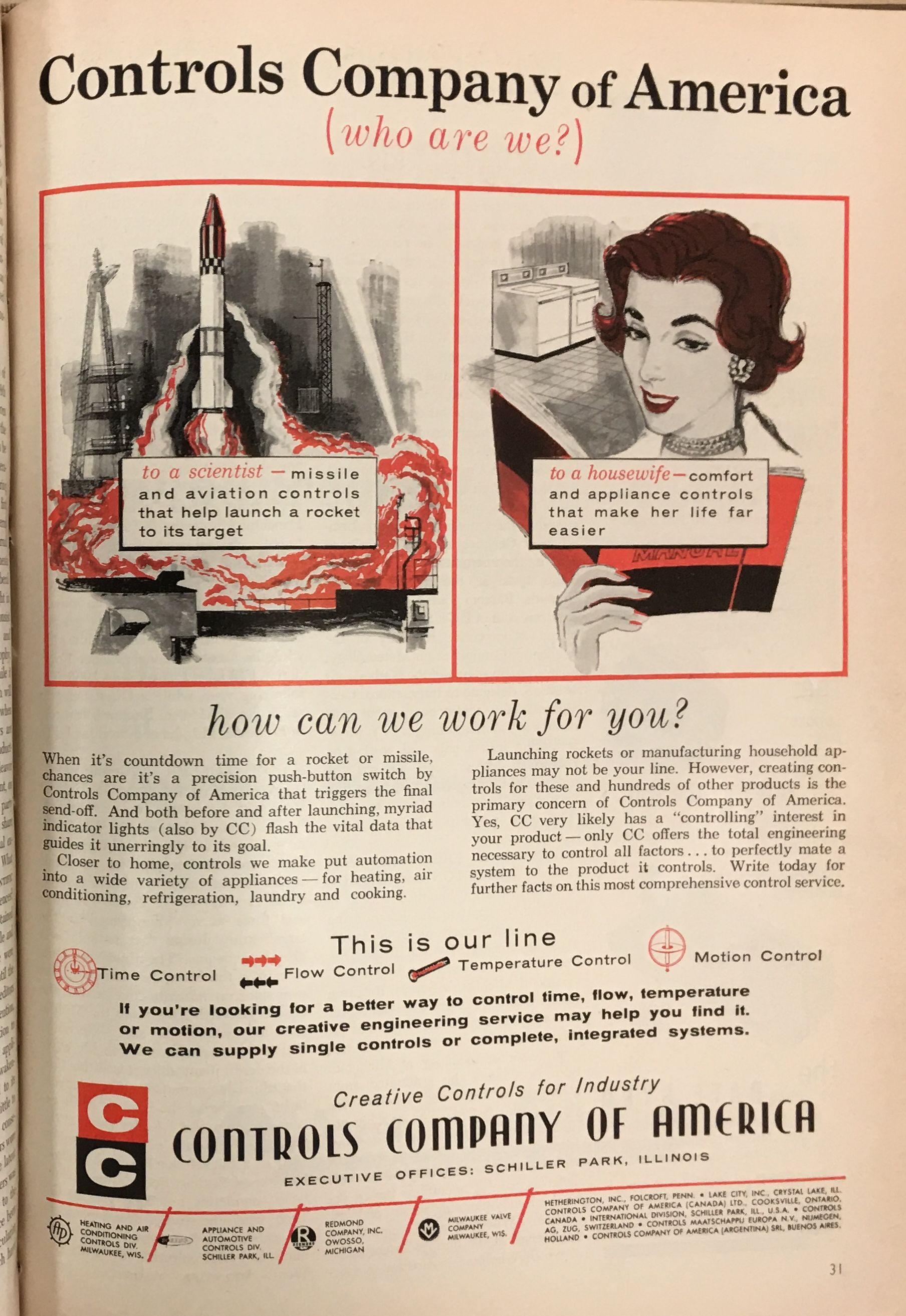
Scientific American 200, No. 4 (1959)
For an anthropologist, these moments of anxiety and strangeness associated with nuclear weapons are very interesting topics for productive analysis. Occult and unintelligible information about nuclear weapons and nuclear wars opens up a vast field for personal and cultural imagination to build your own concepts about how these things may look. A mundane reality has few chances to support our ideas about nuclear bombs that we generate for complacency. From my point of view, as well as from the point of view of some of my acquaintances, the apocalyptic nature of nuclear weapons requires that the procedures and equipment intended for its use are appropriately solemn, complex and impressive. But in reality they are not. At least in the USA, nuclear weapons were developed for unconditional and quick use in the event of validation. And it's not for nothing that pre-flight controllers resemble control systems for ovens and washing machines. They were created with the same concern for simplicity and high speed work.

Stromberg-Carlson. “Talent for control systems” Scientific American 202, no. 1 (1960)
I would say that the fear of nuclear weapons, this feeling of discomfort and anxiety experienced by some people when they encounter the banality of nuclear weapons controls, is similar to what I met (and experienced myself) in discussing the procedures for launching nuclear weapons in the United States. Secrecy and opacity have done a lot to spread popular convictions about restrictions on the use of weapons for the US president. One gets the feeling that the president has a virtually uncontrollable ability to issue an order to use nuclear weapons. The control and monitoring system for US nuclear weapons, which materialized the metronym for which the preflight controllers are, were specially created so that they could quickly react to an authorized launch order. By definition, almost all orders of the president to launch AO are authorized.
And now - illustrating anecdote. As part of the “New Mexico Nuclear” class at the University of New Mexico, in the fall of 2016, I was in an expert group that gathered after the public screening of the Command and Control documentary ( a better book ). The discussion turned to the procedures for launching nuclear weapons in the United States. One person called my description “simplified” and claimed that I forgot to take into account the “checks and balances” of using nuclear weapons by the president, but at the same time he refused to tell them in detail. Personally, it is quite difficult for me, participating in disputes of this kind, not to recall the psychological mechanism that Robert Lifton called "mental numbness": the emergence of ideas and emotional "corns" that allow us to ignore the ever-present possibility of nuclear annihilation of the world.
One way or another, the next part of this article will be entertaining: there will be pictures and comments! All images of pre-flight controllers and bombs are mine, with the exception of having special posts. Enjoy.
What are preflight controllers and what are they for?
Preflight controllers are devices used by the ground command to adjust the supply method and the power output of the NF, as well as to unlock the weapon before the flight. For some bombers, all these settings can be made using the equipment of the aircraft monitoring and control system (Aircraft Monitoring And Control, AMAC). For other planes, these settings must be made on the ground before flight. Based on my acquaintance with declassified documents and third-party sources, then I make my rather plausible assumptions about the appointment of all these pens and buttons.
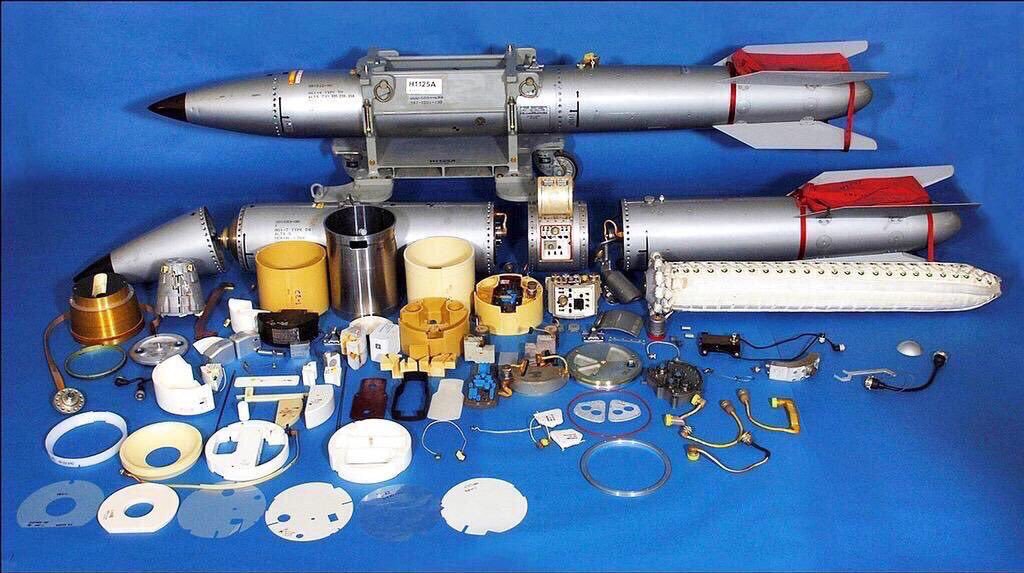
Disassembled B61
The nuclear bomb B61 today is presented in the US arsenal in modifications (mods) 3, 4, 10 (so-called tactical versions), 7 (strategic) and 11 (penetrating). Today, the life extension program B61 is engaged in the conversion of B61-4 to B61-12, which will have four explosion variants, from 0.3 kt to 50 kt. B61-12 will get rid of the parachute in favor of the guide tail device. It is likely that all other B61 and B83 modes will retire after that. Here I am discussing the pre-flight controller for the two outdated versions of the B61: mods 0 and 5. I’ll start with the B61-5, because it is most similar to the controllers still used.
B61-5
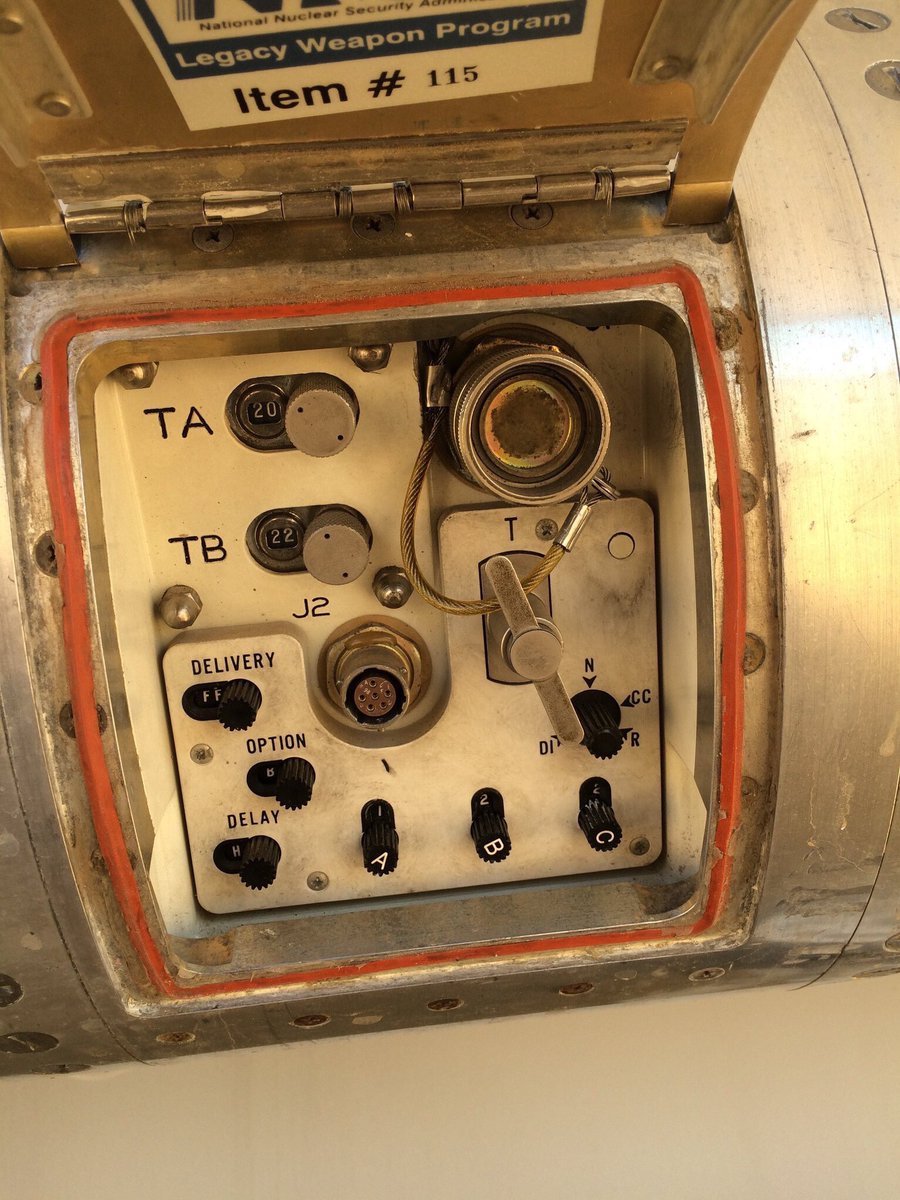
Pre-flight controller B61-5 at NMNSH
Honestly, the B61-5 looks like a shameful relative, which no one remembers after his death. I had difficulty looking for basic information about the B61-5, except that he had a bomb exit setup, and that there were plans to convert it to B61 mods 6 and 8. On the basis of what I read in declassified documents, I would say what the new B61 mods wanted to do was to add extra bombs (1), additional exit options, special missions (7, 11), because of the army’s reluctance to dismantle the warheads of other systems (10) and for security and upgrades. We begin the description of the controller from the upper left corner and go counterclockwise.
TA, TB: 10-69
It is not surprising that airplanes in flight are quite sensitive to the consequences of nuclear explosions, so the B61 was designed so that the delivery of these weapons could be carried out by a low-flying aircraft. The TA / TB switches set up “time to leave the epicenter for two independent planes,” which must pass before the bomb explodes — this gives the plane time to leave the scene of the explosion. The range of intervals is from 10 to 69 seconds, and the team selects TA and TV using the equipment on the plane.
J2
This is the opening for the key to enable the trigger. I think that the key closes the circuit of the internal power systems.
DELIVERY: FF or RE
Choose between free fall delivery and parachute. The team makes a choice with the help of AMAC equipment.
OPTION: A, B, C, D, E, F
Most of the B61 mods had a choice of the power output of the bomb using the “set output” function (Dial-A-Yield, DAY). There are six choice options, in all open sources only four exit options are mentioned for any mod. As I understand it, the penetrating weapon B61-11 had only one exit, 400 kilotons. The B61-5 could switch from 10 to 150 kt, which is very similar to the W80 warhead.
DELAY: G, H, J
In the case of parachute delivery, there was a delay between the dropping of the bomb and the release of the parachute. G = 0.3 s, H = 0.6 s and J = 1.6 s. For an explosion after falling to the ground (using a parachute), the delay between hitting the ground and detonation is adjusted here. G and H - 30 seconds, J = 80 seconds. If you, which is unlikely, suddenly find yourself close to the place where a nuclear bomb descends by parachute, I advise you very quickly to come to terms with the fact that you are mortal.
COMMAND DISABLE SYSTEM: adjustments A, B, & C (0-9); T-shaped handle; adjustment with designations N, CC, DI, & R
The US has a habit of scattering nuclear weapons around the globe, after which the leaders of the countries are worried that their enemies, terrorists or allies will get access to weapons and use them. In the event that, say, US nuclear weapons stored at the Incirlik base in Turkey are threatened with seizure in the event of a coup, the prohibition system will make it possible to disable the weapon. After entering the three-digit code, turn the knob to DI (disable) and pull out the T-handle. The thermopile will start and probably fry some important part of the circuit. After that, you will have to return the weapon to the Panttex nuclear weapons manufacturing plant for repair. Or, you can just get plutonium and take it for yourself - but this is a terrible headache and, probably, there can be an active defense system punishing for penetration through the protective membrane (for example, by means of an explosion). Declassified documents are silent about all this, but this is not such a crazy opportunity. Like PAL, the ban system will give you some time, but this is probably not 100% protection against penetration. It is better not to let the nuclear weapons out of sight.
J1
Connector for PAL. This connects the cable from the ground equipment, through which you can lock, unlock, recode and check the status of the bomb. PAL is probably coded switches connected to critical circuits. Without entering the correct key, the weapon will not detonate. Some aircraft have installed AMAC equipment that performs PAL functions; on others, weapons must be unlocked on the ground before the flight.
B61-0

In the case of the B61-0, the first B61 bomb, everything works almost as well, except, apparently, the absence of a control ban system. Not sure exactly when it became a standard part of the B61.
B83

B83 - the only megaton bomb (1.2 Mt) in the United States. He, like the full melting weapon (Full Fuzing Options, FUFO), like the B61, has more settings than drinks in the casino. Consider the panel from top to bottom and we will move from left to right.
DELAY: G, H, J
The time after the release of the bomb, through which the parachute will open, or, for free fall, the time after the fall, after which the bomb will jerk.
FUNC: A, B, C, D, blank, blank
This is probably an exit selector, Dial-A-Yield. The maximum output of the B83 is 1.2 megatons, but I haven’t seen any other possibilities. Interestingly, the B61-0, -5 controllers have six such settings, while the B83 has four and two positions are empty.
DELIVERY: FF, R1, R2
Explosion options at B83 more than pizza options at "Papa Johns." FF - free fall, R - release of a parachute. Not sure about the difference between R1 and R2. Perhaps this is the choice of an explosion in the air or an explosion on the ground, but this is questionable due to the existence of the CONT / HOB setting.
CONT / HOB: CL, PL, PH, CH
I suppose these are variants of an explosion in the air, upon contact or delivery by parachute. I do not know what these abbreviations mean. H - maybe high, and L - low? Also, I'm not sure at what height the explosion will take place, if you choose this option, it is possible that the pilot chooses it with the help of AMAC. Choosing the exact height makes sense because it allows you to maximize the coverage area in specific conditions.
TA, TB
Sets the minimum separation time from the time the bomb was dropped to the time of the explosion. The safe time is set up and down with switches. They go from 00 to 99 (switches for tens and ones), but the actual waiting time may not reach 99 seconds. For example, on non-produced B61-6 and 8, the maximum time can be set to 99, but the real time does not exceed 69 seconds.
J1
PAL connector for locking / unlocking, status checking, etc. On some planes, all this can be done from the cockpit through AMAC. AMAC connects to the top of the weapon. In the museum, the B83 exhibits with a T1563 PAL controller and a T1571B power supply. The photo shows the cable coming from the controller.
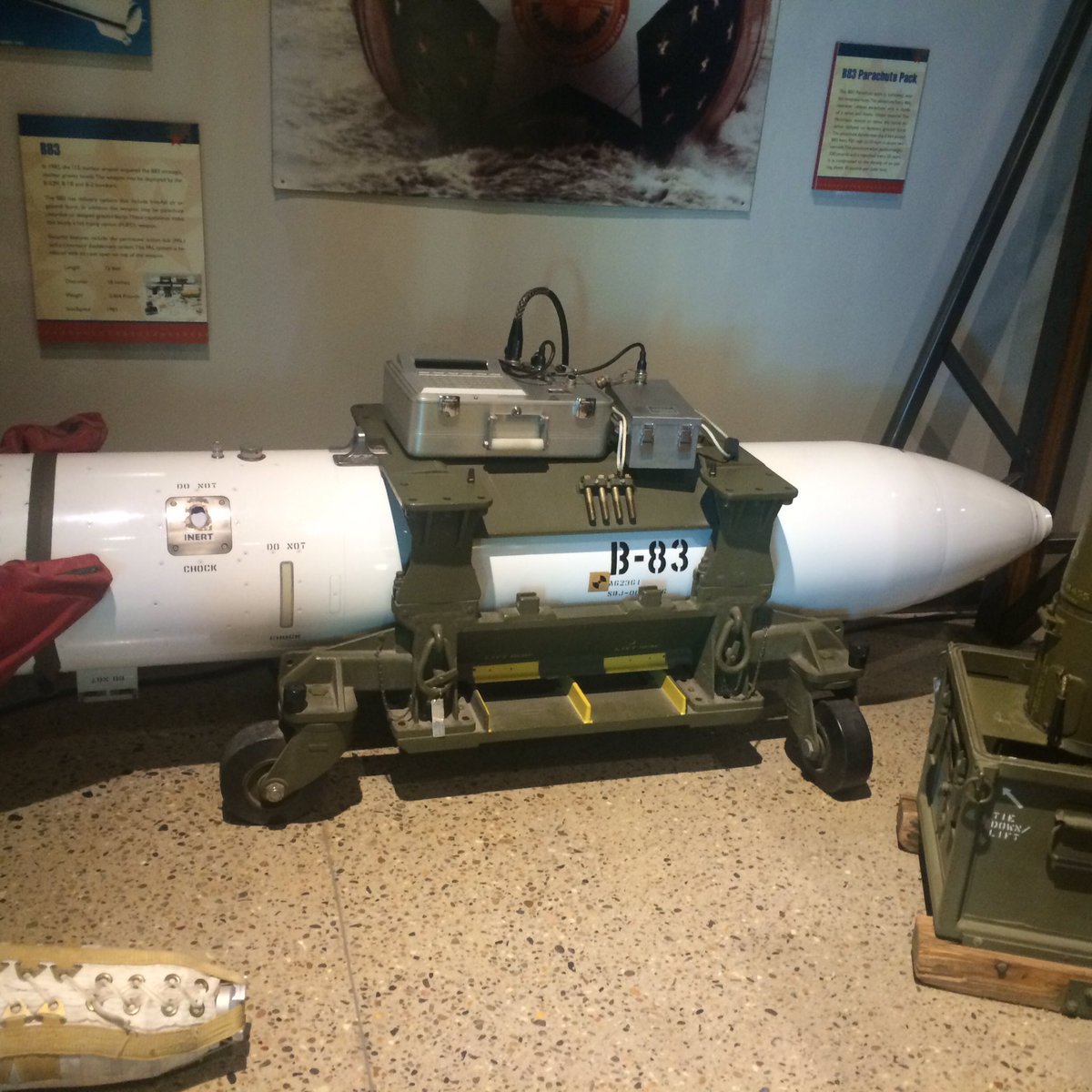
COMMAND DISABLE SYSTEM: A, B, C (0-9); T-handle; pen with “N,” “CC,” “DI,” and “R”
Setting the desired code through A, B, C, turning the knob to DI and pulling out the T-handle starts the thermopile in the controller, which makes the weapon unusable. Judging by the declassified documents, everything happens inside the "protected volume", and, probably, in the nuclear subsystem itself. Guesses on this subject go from the melting of the detonators to the explosion of small charges that kill the necessary wiring diagrams.
WE177 Ground Controller
The WE177 is a British bomb, produced in three major versions from 1966 about 1998. Apparently, the functional equivalent of the American preflight controller. In Britain, it was called the "Ground Control Unit" [Ground Control Unit, GCU]

GCU is fun to compare with controllers from the United States. There are no such things as a ban system or a PAL connector. Access control was physically carried out using a bicycle-like lock. Starting from the top left, and clockwise:

“L”, “H”
WE177A was the only version of the bomb with a choice of output. L (apparently Low) - 0.6 kt, and H - 10 kt. When choosing the output power of 0.5 kt, the bomb was used as a depth one.
“AIRBURST / GROUND BACK-UP”: “LOW,” “HIGH”; “OUT,” “IN,” “OUT,” “IN”
Like the B61, the WE177 could be delivered both by parachute and free fall. This handle allows you to choose the possibility of an explosion after a fall in case the explosion in the air did not work.
ARMING TIME SEC., PRIMARY & ALTERNATIVE: 8, 14, 20, 26, 32, 38, 44, 50
The time before the explosion. According to legend, the queen herself chose these time intervals! Just kidding, of course, but I have no more logical or plausible explanation for such a choice of time. Brian Burnell describes this time as setting the delay between dropping weapons from an airplane and launching the radar. This time is necessary for the aircraft to leave the scene of the explosion. Also, this setting reduces the likelihood of the enemy killing weapons.
CHUTE DELAY: A, B, C
The time delay between the discharge of the weapon and the operation of the parachute.
SEF: “Strike Enable Facility”
At the last stage of putting into operation of the WE177, the team on the ground inserted something, strongly resembling the key to the bicycle lock, into the slot and turned it. After that, the weapon was ready for use. No coded switches or double keys.
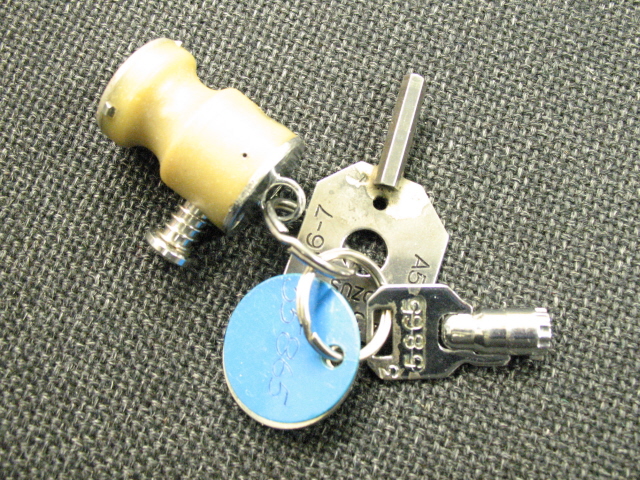
TEST
I believe that through this port it was possible to check the status of weapons, food, etc.
Conclusion
I hope you enjoyed this compilation. If you have additional sources of information or ideas about the details unknown to the author, share them! The last remark: it is worth mentioning that the United States is rather non-standard approach to the delivery and preparation of nuclear weapons. China, India, Pakistan and (probably) Israel do not store weapons complete with delivery systems. Today, only the United States and Russia practice a functional combined delivery system scheme, while Russia traditionally has a lower readiness to deliver nuclear weapons than the United States. The United States is unusual, and perhaps uniquely suited to the autonomy of its weapon and the ability to launch it, depending on one person. It is high time to review the structure of nuclear weapons and the agreements related to them, so that one person does not have the power to destroy our entire world.
Information sources
Bellovin, Steven M. “Permissive Action Links.” Www.cs.columbia.edu/~smb/nsam-160/pal.html#CAH84 , 2017. Accessed 06/12/2017.
Bradbury, Norris K., and Schwartz, GP “NATO Weapons.” AW-765, Memo to General Starbird. www.cs.columbia.edu/~smb/nsam-160/pal-design.pdf , January 5, 1961. Accessed 06/07/2017.
Burnell, Brian. “We.177.” Nuclear Weapons: A Guide to British Nuclear Weapon Projects. nuclear-weapons.info/vw.htm#WE.177 , 2016. Accessed 06/17/2017.
Controls Company of America. “Who Are We.” Scientific American 200, no. 4 (1959): 31.
Derrida, Jacques. “No Apocalypse, Not Now (Full Speed Ahead, Seven Missiles, Seven Missives).” Translated by Catherine Porter and Philip Lewis. Diacritics 14, no. 2 (1984): 20–31.
“Glenn.” “B61 Nuclear Bomb Preflight Controller.” Glenn's Computer Museum. www.glennsmuseum.com/controller/controller.html , 2010. Accessed 06/12/2017.
Huard, Paul Richard. “When to Shoot a Nuclear Bomb with Your Gun.” War is Boring. medium.com/war-is-boring/when-to-shoot-a-nuclear-bomb-with-your-gun-f1f97093a64e , January 30, 2015. Accessed 06/16/2017.
Kidder, RE “Report to Congress: Nuclear Test Requirements: Nuclear Test Requirements.” UCRL-LR-107454. Lawrence Livermore National Laboratory: Livermore, CA. fas.org/programs/ssp/nukes/testing/kidderucrllr107454.pdf , July 26, 1991. Accessed 06/12/2017.
Joseph Masco. The Nuclear Borderlands: The New York City War Managers Princeton: Princeton University Press, 2006.
Kenner, Robert. “Command and Control.” Film. Robert Kenner Films, 2016.
Kristensen, Hans M., and Robert S. Norris. “The B61 Family of Nuclear Bombs.” Bulletin of the Atomic Scientists 70, no. 3 (2014): 79-84.
Lifton, Robert J., and Robert Falk. Indefensible Weapons: The Psychological and Political Case Against Nuclearism. New York: Basic Books, 1982.
Plummer, David W., and William H. Greenwood. “The History of Nuclear Weapon Safety Devices.” SAND-98-1184C. Sandia National Laboratories: Albuquerque. www.osti.gov/scitech/biblio/671923 , 1998. Accessed 06/07/2017.
Sandia National Laboratories. “Interim Development Report for the B61-6,8 Bombs.” SAND88-2986. Sandia National Laboratories, Albuquerque. nnsa.energy.gov/interim-development-report-b61-68-bombspdf-3714kb , 1989. Accessed 06/12/2017.
Sandia National Laboratories. “PAL Control of Nuclear Weapons.” SAND82-2436. Sandia National Laboratories: Albuquerque. www.cs.columbia.edu/~smb/nsam-160/Theater_Control/Theater_Control.pdf , 1984. Accessed 06/07/2017.
Stein, Peter and Peter Feaver. Weapons: The Evolution of Permissive Action Links. Lanham: CSIA Occasional Paper Series, 1987.
Stromberg-Carlson. “A Talent for Command Control Systems.” Scientific American 202, no. 1 (1960): 137.
Wellerstein, Alex. “The President and the Bomb, Part III.” Restricted Data: The Nuclear Secrecy Blog. blog.nuclearsecrecy.com/2017/04/10/president-bomb-iii , April 10, 2017. Accessed 07/07/2017.
Wolfgang, Raymond B. “The Enhanced Nuclear Detonation Safety Theme - an Introduction.” SAND2012-0793C. Sandia National Laboratories, Albuquerque. www.osti.gov/scitech/servlets/purl/1090221 , 2012. Accessed 06/12/2017.
Bradbury, Norris K., and Schwartz, GP “NATO Weapons.” AW-765, Memo to General Starbird. www.cs.columbia.edu/~smb/nsam-160/pal-design.pdf , January 5, 1961. Accessed 06/07/2017.
Burnell, Brian. “We.177.” Nuclear Weapons: A Guide to British Nuclear Weapon Projects. nuclear-weapons.info/vw.htm#WE.177 , 2016. Accessed 06/17/2017.
Controls Company of America. “Who Are We.” Scientific American 200, no. 4 (1959): 31.
Derrida, Jacques. “No Apocalypse, Not Now (Full Speed Ahead, Seven Missiles, Seven Missives).” Translated by Catherine Porter and Philip Lewis. Diacritics 14, no. 2 (1984): 20–31.
“Glenn.” “B61 Nuclear Bomb Preflight Controller.” Glenn's Computer Museum. www.glennsmuseum.com/controller/controller.html , 2010. Accessed 06/12/2017.
Huard, Paul Richard. “When to Shoot a Nuclear Bomb with Your Gun.” War is Boring. medium.com/war-is-boring/when-to-shoot-a-nuclear-bomb-with-your-gun-f1f97093a64e , January 30, 2015. Accessed 06/16/2017.
Kidder, RE “Report to Congress: Nuclear Test Requirements: Nuclear Test Requirements.” UCRL-LR-107454. Lawrence Livermore National Laboratory: Livermore, CA. fas.org/programs/ssp/nukes/testing/kidderucrllr107454.pdf , July 26, 1991. Accessed 06/12/2017.
Joseph Masco. The Nuclear Borderlands: The New York City War Managers Princeton: Princeton University Press, 2006.
Kenner, Robert. “Command and Control.” Film. Robert Kenner Films, 2016.
Kristensen, Hans M., and Robert S. Norris. “The B61 Family of Nuclear Bombs.” Bulletin of the Atomic Scientists 70, no. 3 (2014): 79-84.
Lifton, Robert J., and Robert Falk. Indefensible Weapons: The Psychological and Political Case Against Nuclearism. New York: Basic Books, 1982.
Plummer, David W., and William H. Greenwood. “The History of Nuclear Weapon Safety Devices.” SAND-98-1184C. Sandia National Laboratories: Albuquerque. www.osti.gov/scitech/biblio/671923 , 1998. Accessed 06/07/2017.
Sandia National Laboratories. “Interim Development Report for the B61-6,8 Bombs.” SAND88-2986. Sandia National Laboratories, Albuquerque. nnsa.energy.gov/interim-development-report-b61-68-bombspdf-3714kb , 1989. Accessed 06/12/2017.
Sandia National Laboratories. “PAL Control of Nuclear Weapons.” SAND82-2436. Sandia National Laboratories: Albuquerque. www.cs.columbia.edu/~smb/nsam-160/Theater_Control/Theater_Control.pdf , 1984. Accessed 06/07/2017.
Stein, Peter and Peter Feaver. Weapons: The Evolution of Permissive Action Links. Lanham: CSIA Occasional Paper Series, 1987.
Stromberg-Carlson. “A Talent for Command Control Systems.” Scientific American 202, no. 1 (1960): 137.
Wellerstein, Alex. “The President and the Bomb, Part III.” Restricted Data: The Nuclear Secrecy Blog. blog.nuclearsecrecy.com/2017/04/10/president-bomb-iii , April 10, 2017. Accessed 07/07/2017.
Wolfgang, Raymond B. “The Enhanced Nuclear Detonation Safety Theme - an Introduction.” SAND2012-0793C. Sandia National Laboratories, Albuquerque. www.osti.gov/scitech/servlets/purl/1090221 , 2012. Accessed 06/12/2017.
All Articles